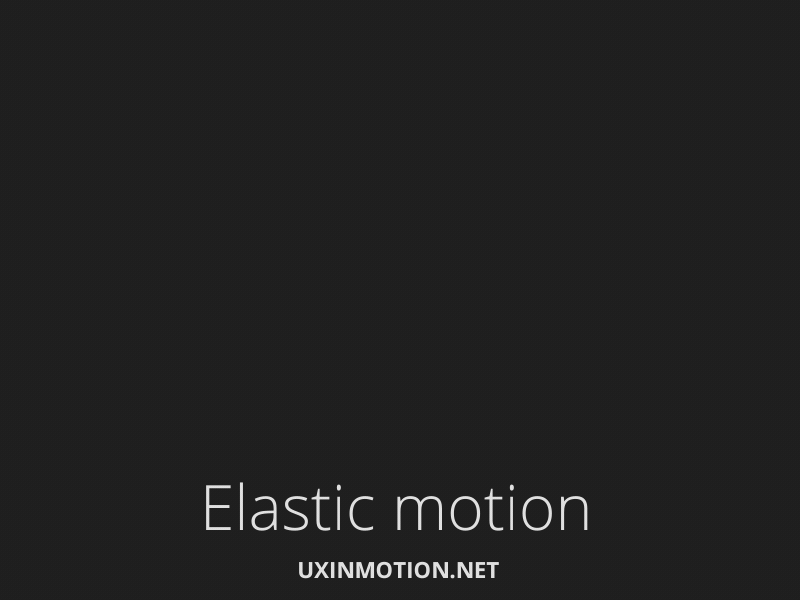Principle 1: Easing
Object behavior aligns with user expectations when temporal events occur.
 All interface objects exhibiting temporal behavior (whether realtime or non-realtime), ease. Easing creates and reinforces the 'naturalism' inherent in the seamlessness of user experiences, and creates a sense of continuity when objects behave as users expect them to. Incidentally, Disney refers to this as 'Slow In and Slow Out.'
All interface objects exhibiting temporal behavior (whether realtime or non-realtime), ease. Easing creates and reinforces the 'naturalism' inherent in the seamlessness of user experiences, and creates a sense of continuity when objects behave as users expect them to. Incidentally, Disney refers to this as 'Slow In and Slow Out.'

 The example on the left has linear motion and looks 'bad.' The first example up top has eased motion and looks 'good.' All three above examples have the exact number of frames and take place over the exact same amount of time. The only difference is in their easing.
As designers concerned with usability, we need to require of ourselves rigor and inquire, aside from aesthetics, which example supports usability more?
The case I am presenting here is that a certain degree of skeuomorphism is inherent in easing. You can imagine an 'easing gradient' wherein behaviors that fall outside user expectations result in less usable interactions. In the case of properly eased motion, users experience the motion itself as seamless and largely invisible - which is a good thing in that it is non-distracting. Linear motion is visibly obvious and feels somehow off, unfinished, and jarring, and distracting.
Now I'm going to completely contradict myself here and talk about the example on the right. The motion isn't seamless. In fact, it has a 'designed' feel to it. We notice how the object lands. It feels different, yet it still feels more 'correct' than the example with linear motion.
Can you employ easing and still have it not support (or worse case undermine) usability? The answer is yes, and there are several ways. One way is timing. If your timing is too slow (mushy to borrow from Pasquele), or too fast, you can break expectation and distract user attention. Similarly, if your easing is misaligned with the brand or overall experience, this can also negatively impact expectation and seamlessness.
What I want to open you to is a world of opportunity when it comes to eased motion. There are literally an infinite number of 'easings' that you as a designer can create and implement in your projects. All of these easings have their own expectation response they trigger in users.
To summarize: when to use easing? Always.
You can learn more on my easing hypothesis in my article, 'The irony of usability and linear motion.'
The example on the left has linear motion and looks 'bad.' The first example up top has eased motion and looks 'good.' All three above examples have the exact number of frames and take place over the exact same amount of time. The only difference is in their easing.
As designers concerned with usability, we need to require of ourselves rigor and inquire, aside from aesthetics, which example supports usability more?
The case I am presenting here is that a certain degree of skeuomorphism is inherent in easing. You can imagine an 'easing gradient' wherein behaviors that fall outside user expectations result in less usable interactions. In the case of properly eased motion, users experience the motion itself as seamless and largely invisible - which is a good thing in that it is non-distracting. Linear motion is visibly obvious and feels somehow off, unfinished, and jarring, and distracting.
Now I'm going to completely contradict myself here and talk about the example on the right. The motion isn't seamless. In fact, it has a 'designed' feel to it. We notice how the object lands. It feels different, yet it still feels more 'correct' than the example with linear motion.
Can you employ easing and still have it not support (or worse case undermine) usability? The answer is yes, and there are several ways. One way is timing. If your timing is too slow (mushy to borrow from Pasquele), or too fast, you can break expectation and distract user attention. Similarly, if your easing is misaligned with the brand or overall experience, this can also negatively impact expectation and seamlessness.
What I want to open you to is a world of opportunity when it comes to eased motion. There are literally an infinite number of 'easings' that you as a designer can create and implement in your projects. All of these easings have their own expectation response they trigger in users.
To summarize: when to use easing? Always.
You can learn more on my easing hypothesis in my article, 'The irony of usability and linear motion.'